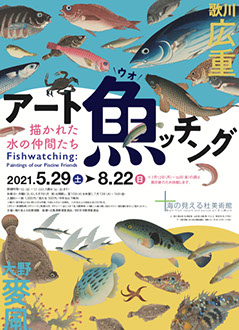Exhibitions
Fishwatching: Paintings of our Piscine Friends
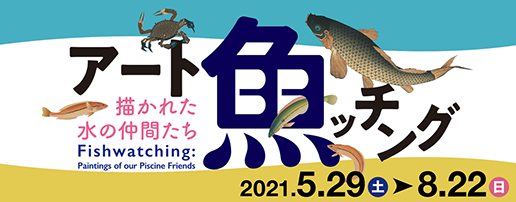
This summer, Umi-Mori Art Museum is holding the exhibition “Fishwatching: Paintings of our Piscine Friends.”
Humans have had an intimate connection with fish since olden times. Not only do they provide a source of food, they also captivate us as they glide freely through their mysterious underwater world. This global fascination has led to the creation of numerous poems, stories, craftworks and paintings featuring our piscine friends. In the East, the presence of tasty fish is a prerequisite for any successful meal or banquet, but these aquatic creatures have also played a more symbolic role. Fish gliding effortlessly through water have long symbolized a free spirit, for example. Schools of fish are also associated with the prosperity of one’s descendants, while fish have become symbols of abundance and good fortune in relation to the idea of bounteous seafood catches.
On a more basic level, artists have been drawn to the beautiful colors and unique forms of fish. Fish were also a common theme of ukiyo-e prints during the Edo period (1603–1868). Many of these ukiyo-e artists were inspired by fish-themed tanka poems and haikai poetry, for instance. An example of this cross pollination is Utagawa Hiroshige’s ‘Every Variety of Fish’ series. This work uses exquisite engraving and coloring to convey the feel of fish scales and skin. Ukiyo-e prints often depict fish commonly found in the markets and kitchens of Edo, but Hiroshige’s outstanding representations were probably based on close observations of live fish.
As the Edo period drew to a close, Western culture began to permeate Japanese society at the dawn of the new Meiji period. Paintings were now infused with artistic individuality, with the focus shifting to the way painters represented their subjects. Examples of this new trend include ‘Gurnard’ by Murakami Kagaku. This shows how artists confronted their subjects and strove to portray them as naturally as possible.
Another captivating aspect of fish is the diversity of their forms and habitats. Ono Bakufu tried to vividly depict living fish in their natural environments. To this end, he visited aquariums (still a novelty in 1930s Japan) and even boarded submarines. His ‘Great Japanese Fish Picture Album’ was released in a limited run of 500 editions and it comprised 6 volumes 72 pages. This exhibition showcases our museum’s collection of 4 volumes and 47 pages.
The exhibition uses these and other works from our collection to explore our endless fascination with fish and the cultural background to fish depictions from the Edo to the Showa period.
Chapter One
Hiroshige’s Fish: The Beloved Fish of the Edo Folk
Japan is a land surrounded by the sea and abounding with rivers and streams. A rich variety of seasonal seafood has graced Japanese tables since ancient times, from bonito in spring to sea eels in summer. As a familiar everyday presence, fish often provided the inspiration for comic tanka poems and haikai poetry during the Edo period (1603–1868). Utagawa Hiroshige (1797–1858) and other ukiyo-e artists created pictures to accompany these verses. Amid a growing interest in natural history, painters also began to observe fish up close and depict them in meticulous detail. One example is Hiroshige’s ‘Every Variety of Fish,’ an ukiyo-e series portraying a diverse range of marine life alongside comic tanka poems. Hiroshige uses exquisite engraving and coloring to convey the very feel of fish scales and skin.
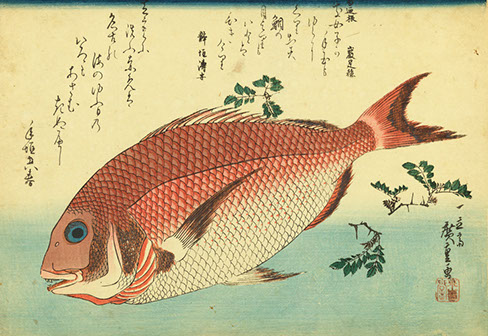
Ca. 1832-1833 (Tenpo 3-4)
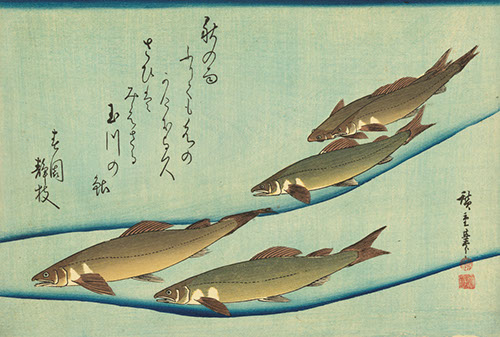
Ca. late Tenpo era
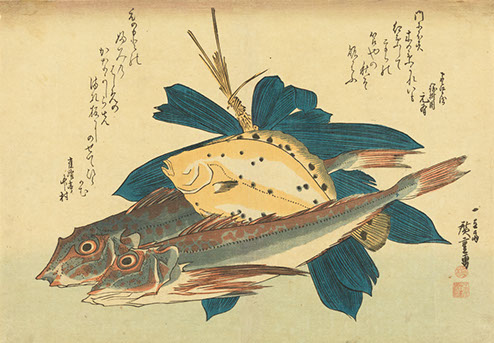
Ca. 1832-1833 (Tenpo 3-4)
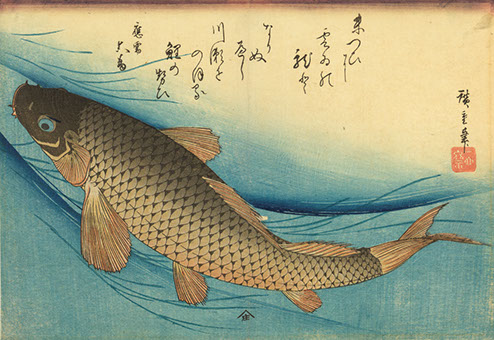
Ca. late Tenpo era
Chapter Two Luck and Love: A Grand Gathering of Auspicious Marine Life!
In China, seafood is an essential part of any festive occasion. This is because the words for ‘fish’ and ‘abundance’ are homonyms in Chinese. Fish is served as an auspicious dish that symbolizes a prosperous, bountiful life. Since ancient times, this auspicious significance has seen fish extolled in Chinese poetry or depicted in Chinese paintings and craft works. This auspicious meaning was transmitted to Japan too. This led to a boom in fish paintings, with carp particularly popular because they symbolized success, an association derived from a Chinese legend stating that carp who manage to jump through the Yellow River’s Dragon Gate will be transformed into dragons. In Japanese, the words for “happiness” and “sea bream” are also homonyms, as are those for “victory” and “bonito” and those for “good fortune” and “blowfish.” In this way, specific auspicious meanings became attached to different fish. This chapter introduces Edo-period carp pictures alongside handbills with auspicious motifs that were distributed over the New Year holidays during the Meiji and Showa eras. Also featured are New Year pictures, still a popular form of decoration in China today.

《Carp Jumping Up Waterfall》
1854 (Kaei 7)

《Carp and Peach Blossom》
1788 (Tenmei 8)
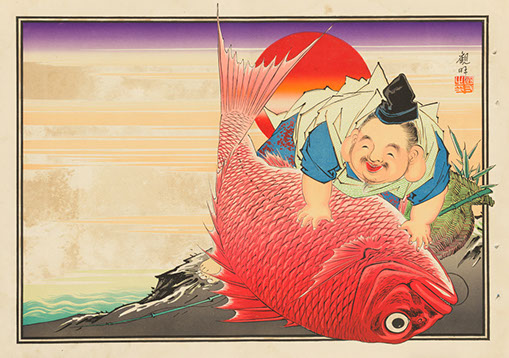
Ca. 1903 (Meiji 36)
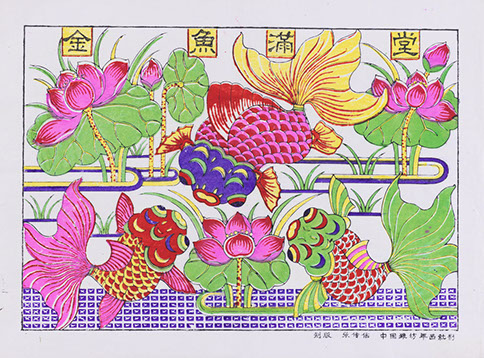
Ca. 1984
Chapter Three The Diverse Colorful Fish of the Modern Masters
In Japan during the Edo period, paintings were used to decorate spaces and create an atmosphere of celebration and auspiciousness. As the Edo period drew to a close, Western culture began to permeate Japanese society at the dawn of the new Meiji era. Artistic individuality now became an important component of paintings. While inheriting traditional themes, painters now began to infuse paintings with their own unique sense of ‘beauty’ and ‘truth.’
This chapter focuses on fish pictures from the Meiji era to the start of the Showa era. Takeuchi Seiho strove to infuse his works with a sense of refreshing summer coolness by portraying fish frolicking in flowing rivers, while Murakami Kagaku tried to depict marine life in a meticulously naturalistic manner that conveyed a sense of texture and weight. The diversity of these works reveals the different ways each artist saw fish. Please enjoy this introduction to diverse, idiosyncratic fish of the modern masters.
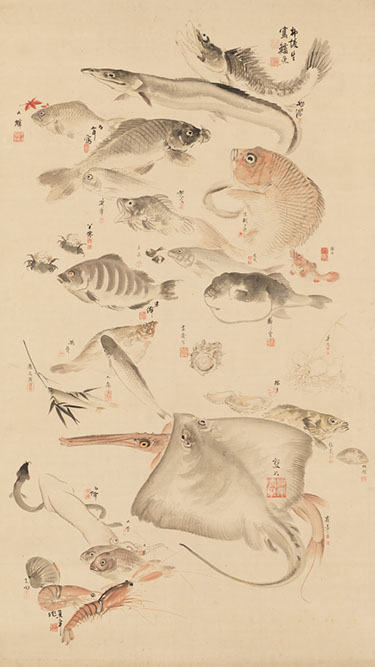
《All Kinds of Sea and Shellfish》
1872-1873 (Meiji 5-6)
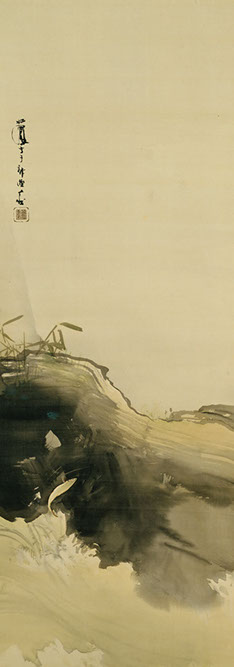
《Jumping Fish in a Summer Valley》 Ca. 1902 (Meiji 35)
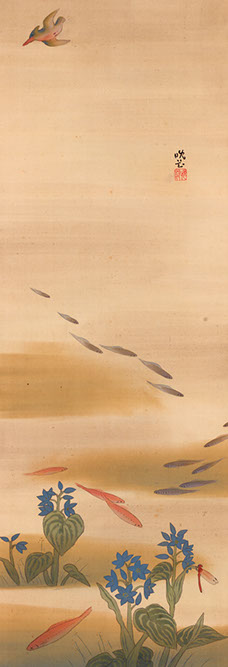
《Summer Pond》
Taisho era
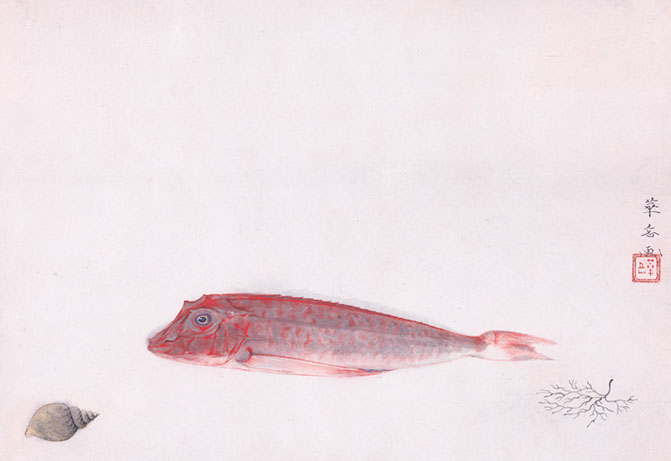
End of Taisho era
Chapter Four Ono Bakufu and the ‘Pictures of Fish in Japan’
pturing the exquisite colors and tones of fish bodies.
After completing and publishing the album during the dark days of the Second World War, Bakufu became known as the ‘fish painter’ and he went on to create many works depicting different fish species.
Over 6 volumes and 72 pages, the ‘Great Japanese Fish Picture Album’ reveals Bakufu’s superlative talents as a painter, engraver and woodblock printer. This chapter showcases our museum’s collection of 4 volumes and 47 This chapter introduces Ono Bakufu and his ‘Great Japanese Fish Picture Album.’
Five hundred editions of this collection of woodblock prints were released over a seven-year period from 1937 by Nishinomiya Shoin, a publishing house in Hyogo Prefecture. Bakufu was responsible for the album’s pictures and he set out to portray fish and their habitats fish in realistic way. To this end, he visited aquariums (still a novelty in 1930s Japan) and even boarded submarines to observe real live fish. By using 200 separate woodblocks to create each print, Bakufu succeeded in capages from the Album. We hope you enjoy this voyage through Bakufu’s beautiful watery world.
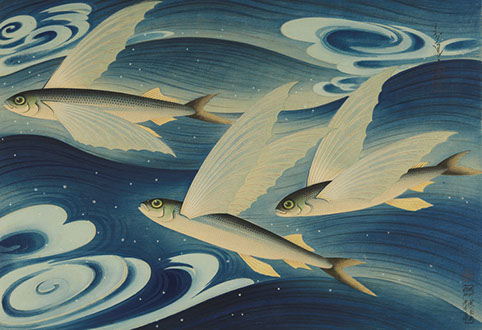
Volume 1 6th installment 「Flying Fish」
January 1938 (Showa 13)
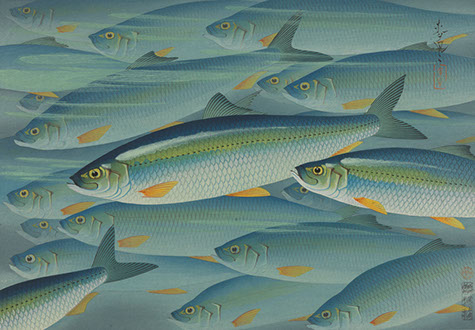
Volume 4 5th installment 「Herring」
January 1941 (Showa 16)
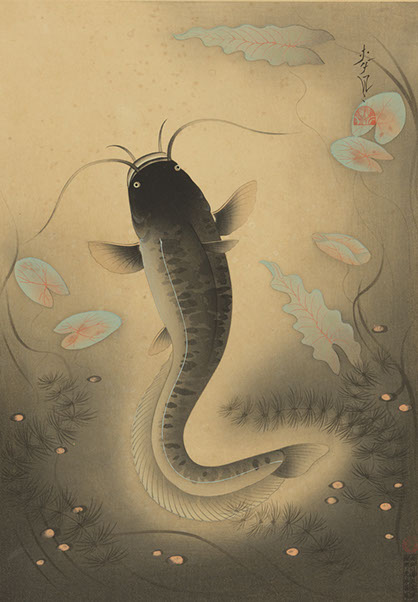
Volume 2 3rd installment 「Catfish」
November 1938 (Showa 13)
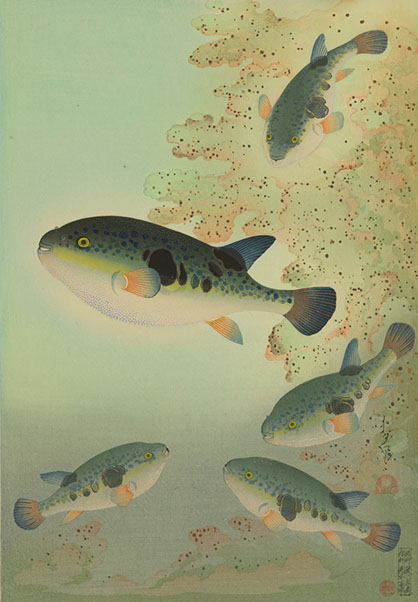
Volume 3 5th installment 「Blowfish」
January 1940 (Showa 15)



